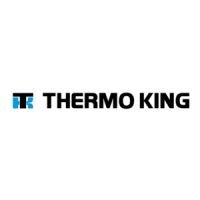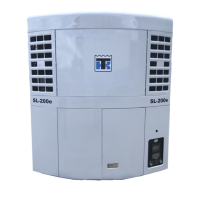Refrigeration Maintenance 10-2
NOTE: Some of the following service procedures are regulated by EU regulation known as "F-Gas" and /or local laws. All
regulated refrigeration service procedures must be performed by a certified technician, using approved equipment and complying
with all EU and local laws.
TG-VI, µP-IV, µP-V, µP-VI, SR-2 and SR-3 NOTE: A Service Test mode on these controllers allows technicians to operate
the unit under known conditions while performing diagnosis and service procedures. See the appropriate Controller
Operation and Diagnosis manual for instructions on how to use the Service Test mode.
SERVICE TOOLS
CAUTION: To prevent contamination, use only service tools certified for and dedicated to the refrigerant type and compressor
oil type used in the temperature control system you are servicing. Service tools (i.e., vacuum pump, gauge hoses and
refrigerant recovery equipment) should be dedicated for non-HFC or HFC refrigerants. Residual non-HFC refrigerants or
non-ester based oils will contaminate and damage HFC systems.
See Thermo King Truck and Trailer Diagnosing manual TK 60201-8-OD for additional information
Leak Detection
Leaks can be detected with the use of soap bubbles or a Halogen leak detector such as the GE H10G (P/N 204-712) or GE H10N
(portable model, P/N 204-756) or a Halogen leak detector with a minimal sensitivity of 5g/year (P/N 204-1888 or equivalent).
NOTE: Periodical leak checks have to comply with F-Gas or national regulation.
Compressor Oil
Polyolester oil (also called ester base oil), P/N 203-413, is required with R-134a, R-404A and R-452A. Because polyol ester oil
has an affinity for moisture, keep it in a closed container and add it as the last step in system repair. Wear rubber gloves when
handling polyol ester oil to prevent possible skin irritation.
Vacuum Pumps
A two-, three- or five-stage vacuum pump is recommended for evacuation. Purging the system with dry nitrogen is recommended
before evacuation.
Because residual refrigerants may remain in used vacuum pumps, a new vacuum pump should be used and dedicated strictly as
a HFC refrigerant pump. Use only recommended vacuum pump oils and change oil after every major evacuation. Because
vacuum pump oils are highly refined to obtain low vacuums, failure to follow these recommendations may result in acidic
conditions that will destroy the pump.
Gauge Manifold Sets
Use self-sealing quick disconnect fittings whenever possible to limit the loss of refrigerant into the atmosphere.
Dedicate and use a separate gauge manifold set and manifold hoses with HFC refrigerants only.
NOTE: Gauge hoses with self-sealing fittings may be removed and re-installed without additional purging if a slight positive
pressure remains in the lines when removed from the unit.
System Clean-up
Existing clean-up devices such as suction line filters and compressor oil filters may be used if they are properly cleaned and new
filters and cartridges are used. All standard petroleum and synthetic compressor oils must be removed from the clean-up devices
to prevent contamination of HFC systems. System failure from contamination will result if non-HFC refrigerants or non-ester
oils are introduced into a HFC system.
Refrigerant Recovery
When servicing an HFC refrigeration system, use only refrigerant recovery equipment approved for and dedicated to HFC
refrigerant recovery.

